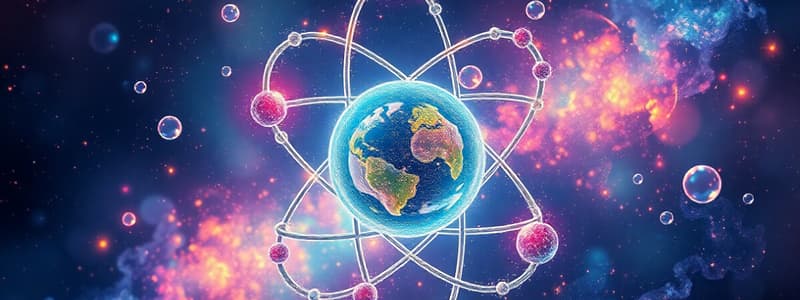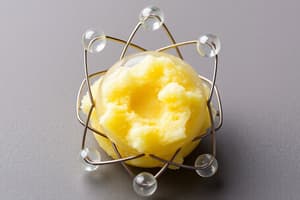Podcast
Questions and Answers
What is a characteristic of pure substances?
What is a characteristic of pure substances?
- They can be separated by physical processes.
- They only contain one chemical species. (correct)
- They consist of two or more types of substances.
- They have a variable composition.
Which statement accurately describes a compound?
Which statement accurately describes a compound?
- A compound is the same as an element.
- A compound can be separated into simpler substances by physical processes.
- A compound can only consist of one element.
- A compound has a fixed composition. (correct)
How can mixtures be distinguished from pure substances?
How can mixtures be distinguished from pure substances?
- Mixtures have a homogeneous composition.
- Mixtures can be separated by physical processes. (correct)
- Mixtures contain only one chemical species.
- Mixtures cannot be separated.
What is the main difference between an element and a compound?
What is the main difference between an element and a compound?
What does the classification of matter include?
What does the classification of matter include?
What is the charge of a neutral atom?
What is the charge of a neutral atom?
Which of the following describes how an atomic ion is formed?
Which of the following describes how an atomic ion is formed?
What net charge does an atom acquire if it loses two electrons?
What net charge does an atom acquire if it loses two electrons?
How does gaining electrons affect the charge of an atom?
How does gaining electrons affect the charge of an atom?
In a neutral carbon atom with 6 protons, how many electrons does it have?
In a neutral carbon atom with 6 protons, how many electrons does it have?
What happens to the net charge of an atom that gains three electrons?
What happens to the net charge of an atom that gains three electrons?
Which statement about atomic ions is incorrect?
Which statement about atomic ions is incorrect?
What defines the charge of a charged fluoride ion (F-)?
What defines the charge of a charged fluoride ion (F-)?
What is the charge of a calcium ion formed during reactions?
What is the charge of a calcium ion formed during reactions?
How is an isotope of an element identified?
How is an isotope of an element identified?
What information does knowing the number of protons provide?
What information does knowing the number of protons provide?
What does a mass number represent?
What does a mass number represent?
If a Ca2+ ion has a mass number of 42, how many neutrons does it contain?
If a Ca2+ ion has a mass number of 42, how many neutrons does it contain?
What is the atomic number of an element associated with the number of protons?
What is the atomic number of an element associated with the number of protons?
Which statement about isotopes is true?
Which statement about isotopes is true?
Which of the following statements is incorrect regarding atomic structure?
Which of the following statements is incorrect regarding atomic structure?
What primarily determines the chemical behavior of atoms?
What primarily determines the chemical behavior of atoms?
How is the atomic mass unit (amu) defined?
How is the atomic mass unit (amu) defined?
Why can't the atomic mass of a single isotope be used for chemical calculations?
Why can't the atomic mass of a single isotope be used for chemical calculations?
What method is used to analyze the distribution of isotopes in an elemental sample?
What method is used to analyze the distribution of isotopes in an elemental sample?
Which of the following properties do isotopes of the same element share?
Which of the following properties do isotopes of the same element share?
What factor primarily affects the physical properties of isotopes?
What factor primarily affects the physical properties of isotopes?
What aspect of isotopes contributes to their differences in physical properties?
What aspect of isotopes contributes to their differences in physical properties?
In a mass spectrum of an elemental sample, which of these indicates the presence of isotopes?
In a mass spectrum of an elemental sample, which of these indicates the presence of isotopes?
What does the average atomic mass of an element represent?
What does the average atomic mass of an element represent?
Where can the weighted averages of atomic masses be found?
Where can the weighted averages of atomic masses be found?
In relation to isotopes, what effect does natural abundance have on average atomic mass?
In relation to isotopes, what effect does natural abundance have on average atomic mass?
What is the average atomic mass of zinc as indicated in the content?
What is the average atomic mass of zinc as indicated in the content?
What is the primary force that holds nucleons together in an atomic nucleus?
What is the primary force that holds nucleons together in an atomic nucleus?
Which of the following best describes an isotope?
Which of the following best describes an isotope?
What does the 'mass spectrum' provide information about?
What does the 'mass spectrum' provide information about?
Which statement regarding atomic masses is true?
Which statement regarding atomic masses is true?
Study Notes
Matter Classification
- Matter can be classified into two categories: pure substances and mixtures
- Pure substances are composed of only one chemical species (element or compound), with a fixed composition.
- Elements are substances that cannot be broken down into simpler substances.
- Compounds are formed by chemically bonded elements, creating a new distinct substance that can be separated back into its elements by chemical means.
- Mixtures contain two or more types of substances with variable compositions and can be separated by physical processes.
Atomic Structure
- An atom is the smallest unit of an element that retains the element's chemical properties.
- Atoms are composed of a nucleus containing protons (positively charged) and neutrons (no charge), surrounded by electrons (negatively charged) in a cloud.
- The atomic number determines the elemental identity based on the number of protons.
- Mass number represents the total number of protons and neutrons in an atom.
- Atoms in their elemental state have a balance of positive and negative charges (equal number of protons and electrons).
- Loss or gain of electrons creates an atomic ion (charged atom), with a net charge of +1 for each electron lost and -1 for each electron gained.
Isotopes
- Isotopes are atoms of the same element having the same number of protons but different numbers of neutrons.
- They are identified by their mass number (total number of protons and neutrons).
- Natural abundance refers to the relative amounts of different isotopes found in a naturally occurring sample of an element.
- The chemical behavior of atoms is primarily determined by their electron configuration, not the number of neutrons.
- Isotopes of the same element have nearly identical chemical properties (bonding and reactivity) due to having the same electron configuration.
- However, isotopes of the same element can differ in physical properties like density and mass.
Atomic Mass
- Atomic mass unit (amu) is defined as one-twelfth the mass of a carbon-12 atom.
- Atomic mass (atomic weight) is the average mass of all isotopes of an element, weighted by their natural abundance.
- Atomic masses are listed below each element symbol on the periodic table.
Nuclear Decay
- The strong nuclear force holds nucleons (protons and neutrons) together in an atomic nucleus.
Studying That Suits You
Use AI to generate personalized quizzes and flashcards to suit your learning preferences.
Related Documents
Description
Test your knowledge on the classification of matter, including pure substances and mixtures, as well as the atomic structure of elements. This quiz will challenge your understanding of atoms, protons, neutrons, and electrons, among other concepts. Perfect for students learning about chemistry fundamentals.




